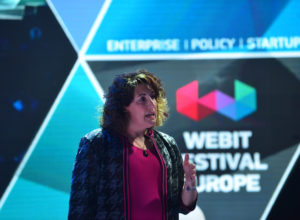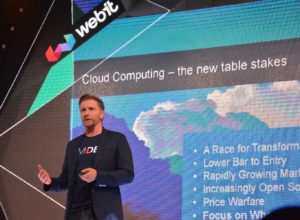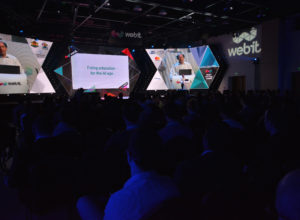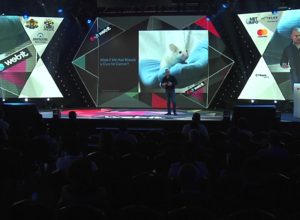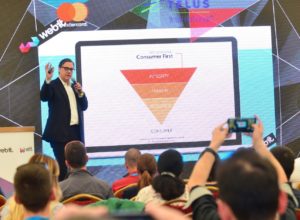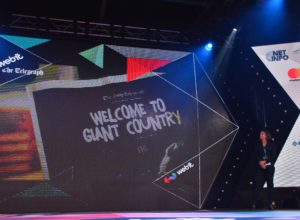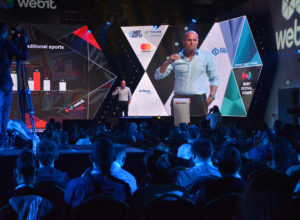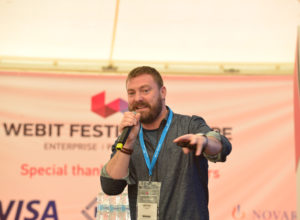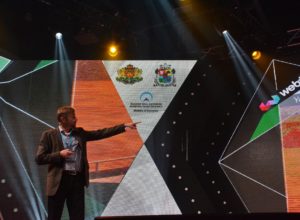Tag: Webit
Big Data will lead to the biggest transformation in healthcare we...
In 1950’s it was estimated that the medical literature doubled every 50 years. By 1980 it was doubling every 3.5 years and by 2020 it will double every 73 days!
More than 8000 new medical articles come out every day. This makes impossible for clinicians to keep up with such volume of data. The information out there is unstructured and is coming in different forms and from different sources.
The only way our medical specialists can cope with the digital reality is with the help of artificial intelligence. During Webit.Festival Europe the Deputy Chief Health Officer for IBM Watson Health Dr. Lisa Latts explained how the latest technological advancements in this field will transform the world of healthcare in the next decades.
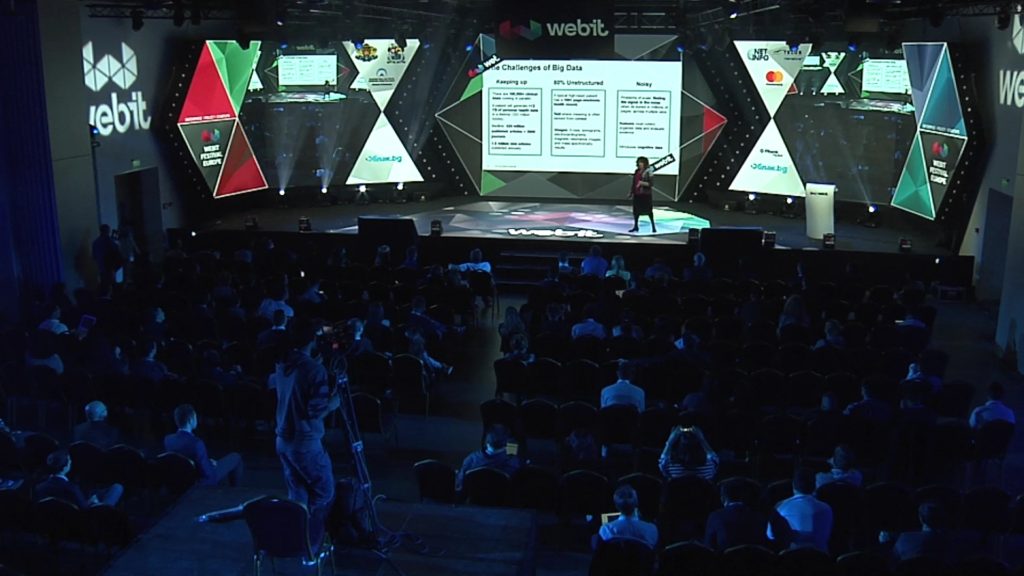 The Deputy Chief Health Officer for IBM Watson Health Dr. Lisa Latts[/caption]
We are now in in the Third age of computer technology. The first age in the early 1900’s was the Tabulating systems era - computers that basically can do math and count. Then in the 1950’s we started with Programmable computers and we are still in that age today where we have computes that we can give a variety of information and tell them what to do with it.
There is so much information available now that it is impossible to program all the characteristics and all the possible programs. So that brings us to the Cognitive computers era. IBM Watson started to work on this in the early 2000’s and 15 years after that was the official launch of Watson Health.
A cognitive computer is different from programmable computer, because it can understand, reason, learn and interact. All of this allows Watson to harness entire bodies of data. It can actually read through the data it is fed to it.
The Deputy Chief Health Officer for IBM Watson Health Dr. Lisa Latts[/caption]
We are now in in the Third age of computer technology. The first age in the early 1900’s was the Tabulating systems era - computers that basically can do math and count. Then in the 1950’s we started with Programmable computers and we are still in that age today where we have computes that we can give a variety of information and tell them what to do with it.
There is so much information available now that it is impossible to program all the characteristics and all the possible programs. So that brings us to the Cognitive computers era. IBM Watson started to work on this in the early 2000’s and 15 years after that was the official launch of Watson Health.
A cognitive computer is different from programmable computer, because it can understand, reason, learn and interact. All of this allows Watson to harness entire bodies of data. It can actually read through the data it is fed to it.
“We have made a lot of advancements in medical technology. Imagine the advancements we could have made if instead of just a fraction of data, we were able to access the entire lexicon of data that is available for an individual. Think what we could do and think of the price of not knowing”, she said.Now, many patients are not able to get the right cancer treatment, because doctors don’t know the exact characteristics of the individual tumor. People with chronic diseases don’t have access to the right medicine, because their doctors don’t have their full medical history. All of these cases are going to change with the help of Big Data. But first, experts, like the ones working in IBM, must deal with several challenges. There are a lot of bad sources of data out there, so you need to be able to separate the true from false. Doctors have got data from medical records, laboratory data, medical literature, radiology data. So they need to be able to aggregate all those forms of information to get a complete picture of what is going on with an individual. If we combine all these we will start to get to the true value of the data and start to really do things with it in terms of what we are delivering to an individual patient. [caption id="attachment_5068" align="aligncenter" width="640"]
 The Deputy Chief Health Officer for IBM Watson Health Dr. Lisa Latts[/caption]
We are now in in the Third age of computer technology. The first age in the early 1900’s was the Tabulating systems era - computers that basically can do math and count. Then in the 1950’s we started with Programmable computers and we are still in that age today where we have computes that we can give a variety of information and tell them what to do with it.
There is so much information available now that it is impossible to program all the characteristics and all the possible programs. So that brings us to the Cognitive computers era. IBM Watson started to work on this in the early 2000’s and 15 years after that was the official launch of Watson Health.
A cognitive computer is different from programmable computer, because it can understand, reason, learn and interact. All of this allows Watson to harness entire bodies of data. It can actually read through the data it is fed to it.
The Deputy Chief Health Officer for IBM Watson Health Dr. Lisa Latts[/caption]
We are now in in the Third age of computer technology. The first age in the early 1900’s was the Tabulating systems era - computers that basically can do math and count. Then in the 1950’s we started with Programmable computers and we are still in that age today where we have computes that we can give a variety of information and tell them what to do with it.
There is so much information available now that it is impossible to program all the characteristics and all the possible programs. So that brings us to the Cognitive computers era. IBM Watson started to work on this in the early 2000’s and 15 years after that was the official launch of Watson Health.
A cognitive computer is different from programmable computer, because it can understand, reason, learn and interact. All of this allows Watson to harness entire bodies of data. It can actually read through the data it is fed to it.
“There is no way that a clinician can keep up with that amount of information, but Watson can. It can read million pages in a second and understand them. It can learn. So it will digest the data and will come up with evidence-based conclusions as a result. Those conclusions may or may not be right, so it takes humans to train Watson in terms of what is right and what is wrong. And it gets better and better over time”, Dr. Latts explained.All this is possible thanks to the Watson Health Platform. It allows IBM to create an ecosystem, which can be used by developers within the company and outside. This has expanded to a network of collaborators and partners creating innovation across the world. Lisa Latts is sure that artificial intelligence will not replace human doctors. Instead, the combination of humans and Watson creates augmented intelligence, that will help them focus on the fields they are better than the machine. It will free up physicians and clinicians for what people and doctors do best - interactive communication. To do their job in the best way possible, physicians need to use interpersonal communication, compassion and to be able to abstract, generalize and dream. Meanwhile, cognitive computer systems are good at taking vast amount of data and come to conclusions. All these factors are used to advance evidence-based care. Traditionally we say that in medicine it takes 17 years for a breakthrough to be translated into clinical best practice. But in the dynamic society we live in, we don’t have the luxury to wait that long any more. Using a Watson-powered solution, clinicians аре quickly armed with evidence-based and ranked treatment options for their consideration. Recommendations based on the patient’s condition and medical evidence are available in approximately 30 seconds. A physician have to read 29 hours each work day to stay up-to-date with the latest medical literature. Watson needs only 3 seconds to read 200 million documents.
“Today we are working on a variety of solutions from cancer care to evidence-based care in a value-based care setting to life science. We, Watson Health, aspire to improve lives and give hope delivering innovation to address the world’s most pressing health challenges through data and cognitive insights”, Latts said.You may watch her full lecture here: If you want to keep up with the latest trend in the world of digital economy and technology, then Webit.Festival is the right place for you. Visit our website and book 2 of our Super Earlybird tickets for Webit.Festival Europe 2018 for just €100. Feel the Webit vibe with some of the best photos from this year’s event! [easingslider id="4954"]
If your company doesn’t like change, it will eventually become irrelevant
If you don’t like change, you are going to like irrelevance a lot less. A famous quote from the former CEO of Ford Alan Mulally that is more than relevant for today’s age of incredible transformation, both for companies and for individuals.
As the Fourth Industrial Revolution is expanding at full speed more and more established enterprises are struggling to transform their existing activities into a more digital businesses.
During Webit.Festival Europe our guest had the chance to have these processes explained by the Vice President for Cloud and Mobile Technology at IBM Jonas Jacobi. His lecture walked us through the latest trends in Cloud Computing, Internet of Everything and Artificial Intelligence that are going to transform the life as we know it today.
According to him, we as users tend to hold on things, whether physical or not, for way too long. And what that does to us and our corporations and companies is that we are holding back the opportunity to realize the future.
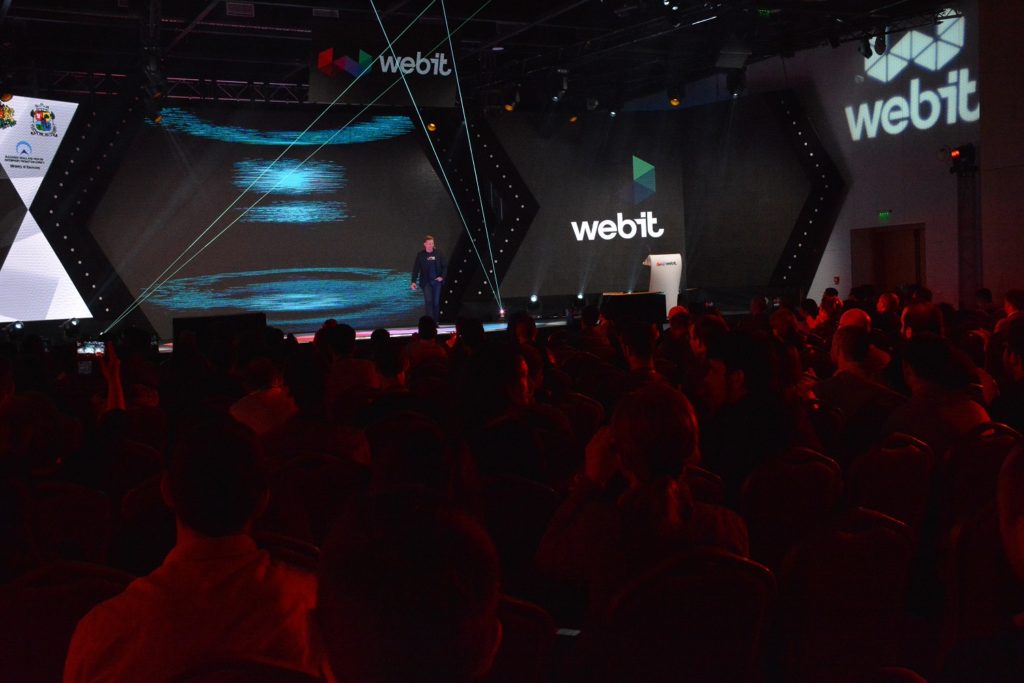 The VP for Cloud and Mobile Technology Strategy at IBM Jonas Jacobi.[/caption]
Connected cars present a giant market opportunity. But now there are even 3D printed self-driving minivans that are with built in AI. We can talk to the bus and communicate with it. We can even ask for a good restaurant and it will take us there. Now technology is not disrupting just one business, but several at the same time.
If you can 3D print a car then you disrupt manufacturing, traffic planning, optimizing traffic fall and making it greener. This is where we are heading. Soon we will just be able to download a blueprint and go print our own personalized car in the shop.
The other giant trend in technology is the rise of Artificial Intelligence. And while many people perceive the adoption of such technology as a start of the battle between the man and machine, the reality is that AI will augment humanity and human intelligence, not replace us.
The VP for Cloud and Mobile Technology Strategy at IBM Jonas Jacobi.[/caption]
Connected cars present a giant market opportunity. But now there are even 3D printed self-driving minivans that are with built in AI. We can talk to the bus and communicate with it. We can even ask for a good restaurant and it will take us there. Now technology is not disrupting just one business, but several at the same time.
If you can 3D print a car then you disrupt manufacturing, traffic planning, optimizing traffic fall and making it greener. This is where we are heading. Soon we will just be able to download a blueprint and go print our own personalized car in the shop.
The other giant trend in technology is the rise of Artificial Intelligence. And while many people perceive the adoption of such technology as a start of the battle between the man and machine, the reality is that AI will augment humanity and human intelligence, not replace us.
“It is important to realize this. If you look at where you are and where you want to be make sure to let go of the past to move on to the future”, the expert said.He reminded that Cloud Computing is actually not a new thing, but we can all give credit to Amazon for making this the number one priority for many companies today. What is important to understand about Cloud Computing is that it is now a must have thing. The Cloud Computing era brought forward a process, called Digital Transformation. A lot of established companies now go through the rapid attempt to digitalize themselves and there is a real race to transform. The other thing that Cloud Computing brought is the lower bar for entry in the space of technology. If we go back 10 or 15 years ago, it required a much bigger minimal investment to try to launch a service. In the ever evolving markets there is a price war and ultimate race to the bottom. As soon as a company comes with a low price, everyone try to chase after. The markets are growing faster than we can actually imagine thanks to trends, such as IoE and AI.
“What that means for all the cloud vendors is that they have to focus on what makes them different. That is the key thing to succeed. It can not all go down to zero in terms of revenue from our services so we have to differentiate”, said Jacobi.The important thing when we look at the things popping out on the market is that they go through some form of evaluation of the market. In the case of connected devices this process is called IoT Chasm and it follows several steps. A new trend comes out and everybody is super excited. We start with the honeymoon period which is like coming to a new place and saying that you are going to stay there forever. Then you start noticing some functions that doesn’t suit you well. But after a while you realize that you are committed to the technology. When a user is already committed, he starts looking not only for convenience, but for things like security of the product. Many IoE companies think of the security as of something that is going to come later. But we are on a stage of development in which someone can hack a car and steer it off the road Once the commitment is a fact, we get into those deeper issues, and as soon as we go through them we get into the major adoption curve of a new technology. [caption id="attachment_5060" align="aligncenter" width="640"]
 The VP for Cloud and Mobile Technology Strategy at IBM Jonas Jacobi.[/caption]
Connected cars present a giant market opportunity. But now there are even 3D printed self-driving minivans that are with built in AI. We can talk to the bus and communicate with it. We can even ask for a good restaurant and it will take us there. Now technology is not disrupting just one business, but several at the same time.
If you can 3D print a car then you disrupt manufacturing, traffic planning, optimizing traffic fall and making it greener. This is where we are heading. Soon we will just be able to download a blueprint and go print our own personalized car in the shop.
The other giant trend in technology is the rise of Artificial Intelligence. And while many people perceive the adoption of such technology as a start of the battle between the man and machine, the reality is that AI will augment humanity and human intelligence, not replace us.
The VP for Cloud and Mobile Technology Strategy at IBM Jonas Jacobi.[/caption]
Connected cars present a giant market opportunity. But now there are even 3D printed self-driving minivans that are with built in AI. We can talk to the bus and communicate with it. We can even ask for a good restaurant and it will take us there. Now technology is not disrupting just one business, but several at the same time.
If you can 3D print a car then you disrupt manufacturing, traffic planning, optimizing traffic fall and making it greener. This is where we are heading. Soon we will just be able to download a blueprint and go print our own personalized car in the shop.
The other giant trend in technology is the rise of Artificial Intelligence. And while many people perceive the adoption of such technology as a start of the battle between the man and machine, the reality is that AI will augment humanity and human intelligence, not replace us.
“At IBM we are working a lot with AI on healthcare. AI can help doctors reach a decision faster, get access to more information faster and anything else in the market. In this case it is an opportunity to improve and safe life of many”, Jacobi said.He thinks that cognitive systems do not think for us, but help us do research and make better decisions. The IBM expert said that no matter how hard we resist and try to push back change, it will inevitably come to us, so we should instead endorse it and bring it in. Because the sooner we adopt new technology, ideas and business models, the faster we can evolve as companies and individuals. You may watch Jonas Jacobi’s full lecture here: If you want to keep up with the latest trend in the world of digital economy and technology, then Webit.Festival is the right place for you. Visit our website and book 2 of our Super Earlybird tickets for Webit.Festival Europe 2018 for just €100. Feel the Webit vibe with some of the best photos from this year’s event! [easingslider id="4954"]
How to fix our education systems for the AI age
We are all talking about the Fourth industrial revolution and its potential toll on the labour market around the world. As the developments of robots, AI and automation seem inevitable, countries, communities and organizations must find ways to adapt our skills to the needs of the future.
During Webit.Festival Europe we had the chance to listen to one of the people that are going to drive this existential change in the processes of learning. The Director of Strategic and International Development at Wolfram Research Conrad Wolfram shared his thoughts on fixing the education for the AI age and took us on a journey through the challenges education faces today.
Wolfram technology and consulting solutions drives innovation in data analytics, software development and modelling from startups to Fortune 500 companies, in industries as diverse as medicine, finance and telecoms.
Conrad is also recognized as a world authority on fixing Math education, including advocating a fundamental shift to focus on computer-based computational thinking rather than hand calculation.
During his speech, he outlined the main effects computers and AI have on education. The first one is that we need to learn subjects that have changed, because the computers now do work that usually humans used to have to do. The second is that AI gives us the tools for building a more personalized learning, assessment and experience during the learning process.
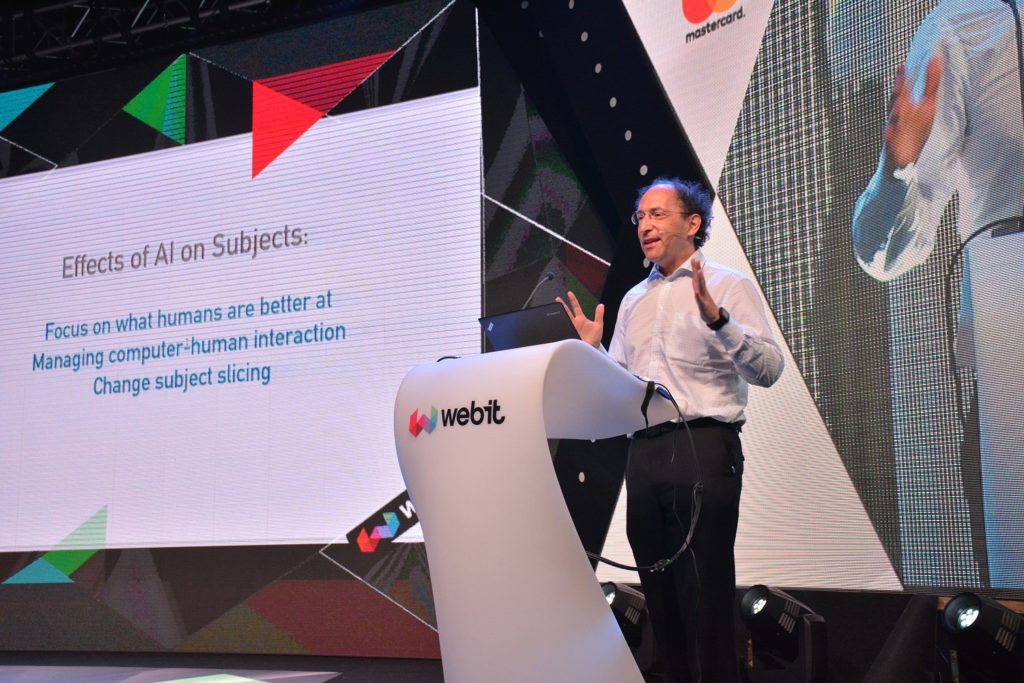 The Director of Strategic and International Development at Wolfram Research Conrad Wolfram.[/caption]
There are at least 3 good reasons for learning the right kind of Math. The first is that it gives us skills for the technical jobs that have powered our economies and continue to do so. The second is that it creates our everyday ability to work in the modern society and deal with the reask that are displayed to us. And the third is that it creates logical thinking about the ways we approach life.
If we talk about the actual essence of Math, we must say that it is a four-step process. You define a question, you translate it to to this abstract notation and the reason you do that is that you can then compute answers much better than you can by talking about it in a normal language, like English or Bulgarian. Then you interpret the results. You take that abstract answer and you go back trying to produce the actual answer to the real question you asked.
The Director of Strategic and International Development at Wolfram Research Conrad Wolfram.[/caption]
There are at least 3 good reasons for learning the right kind of Math. The first is that it gives us skills for the technical jobs that have powered our economies and continue to do so. The second is that it creates our everyday ability to work in the modern society and deal with the reask that are displayed to us. And the third is that it creates logical thinking about the ways we approach life.
If we talk about the actual essence of Math, we must say that it is a four-step process. You define a question, you translate it to to this abstract notation and the reason you do that is that you can then compute answers much better than you can by talking about it in a normal language, like English or Bulgarian. Then you interpret the results. You take that abstract answer and you go back trying to produce the actual answer to the real question you asked.
“The key point to understand is that we need humans to focus on what they are good at and leave computers do the same. And that involves also humans learning how to connect with computers in a meaningful way, so that we have the best interface to get the computers do what we want”, Wolfram said.He gave the example with the ever changing survival skills during the years. Hundreds of years ago it was crucial to be able to make a fire or to kill an animal to eat. There are now different and very modern survival skills to do with computational knowledge. According to him the skill at the top of the future value chain is what we may call computational thinking - knowing how to think in a computational way about life. Around the world we spend many hours of child’s life every week learning Math. But Wolfram thinks that the big question we must ask ourselves is whether this Math is fostering computational thinking, or not? He thinks that right now this is not the wrong subject and we should use all those hours to do much more computational thinking oriented subjects. [caption id="attachment_5052" align="aligncenter" width="640"]
 The Director of Strategic and International Development at Wolfram Research Conrad Wolfram.[/caption]
There are at least 3 good reasons for learning the right kind of Math. The first is that it gives us skills for the technical jobs that have powered our economies and continue to do so. The second is that it creates our everyday ability to work in the modern society and deal with the reask that are displayed to us. And the third is that it creates logical thinking about the ways we approach life.
If we talk about the actual essence of Math, we must say that it is a four-step process. You define a question, you translate it to to this abstract notation and the reason you do that is that you can then compute answers much better than you can by talking about it in a normal language, like English or Bulgarian. Then you interpret the results. You take that abstract answer and you go back trying to produce the actual answer to the real question you asked.
The Director of Strategic and International Development at Wolfram Research Conrad Wolfram.[/caption]
There are at least 3 good reasons for learning the right kind of Math. The first is that it gives us skills for the technical jobs that have powered our economies and continue to do so. The second is that it creates our everyday ability to work in the modern society and deal with the reask that are displayed to us. And the third is that it creates logical thinking about the ways we approach life.
If we talk about the actual essence of Math, we must say that it is a four-step process. You define a question, you translate it to to this abstract notation and the reason you do that is that you can then compute answers much better than you can by talking about it in a normal language, like English or Bulgarian. Then you interpret the results. You take that abstract answer and you go back trying to produce the actual answer to the real question you asked.
“Here is what is going wrong in education. We spend almost all our time learning how to do step 3 by hand. This is the step that computers can do fantastically better than any humans. So what we all should be doing is use computers for step 3 much more and using students much more for steps 1, 2 and 4”, Wolfram said.In school students learn how to solve a linear equation by hand, but in real life the equations we face are much harder and complex. Now our smartphones are able to solve linear equations after a voice command from us. So the key question is why are we spending 10 years of our students lives trying to get them to solve such tasks. Conrad Wolfram founded the computerbasedmath.org to drive implementation of the change. It is now a worldwide force in re-engineering the curriculum with early projects in Estonia, Ireland, Sweden and Africa. The main idea behind the project is that the computer already exist, we have it and it is not going away. And the main task is to figure out how the curriculum should look like. For years we had countries trying to be part of the knowledge economy as opposed to manual labour. The next step is an economy that is driven not only by knowledge, but by the interaction of humans and computation. According to Conrad Wolfram, without a fundamental reform of our education, we are not ready for that. So governments and organizations need to think about innovative ways to unstick the education ecosystem, so that we can have real innovations and not just have to stick with the same things.
“I am avoiding the term Math for much of what I’m now talking, because I think that Math has become a rather toxic word. I like the term computational thinking, but whatever it is called we have to reform what we are doing, either by making a new subjects or by doing a hostile takeover of the old subjects. And it is vital to make that as quickly as possible. Once you got automation in life from machines you need to use it so that humans can go further. We don’t have to make humans compete with the machines, because we will fail”, he said.You may watch Conrad Wolfram’s full lecture here: If you want to keep up with the latest trend in the world of digital economy and technology, then Webit.Festival is the right place for you. Visit our website and book 2 of our Super Earlybird tickets for Webit.Festival Europe 2018 for just €100. Feel the Webit vibe with some of the best photos from this year’s event! [easingslider id="4954"]
IoT is the key to solving the complex world of science
We often think about innovation and science as a one whole thing. But in the age of connectivity and information sharing most of the science-based organizations remain disconnected from the Cloud computing and its amazing capabilities.
Fortunately this is going to change fast because of the fast development of IoT solutions that are going to cut the research and development costs of companies and help them invest more into amazing science discoveries that will benefit all of us.
During the IoE Summit of Webit.Festival Europe the Founder and CEO of Elemental Machines Sridhar Iyengar took us on a journey through the process of making science in the Digital Age and shared his vision about overcoming the obstacles that science-based companies face today.
Sridhar also founded AgaMatrix, a blood glucose monitoring company that made the world’s first medical device connecting directly to the iPhone and shipped 15+ FDA-cleared medical products, 2B+ biosensors, 6M+ glucose meters, with partnerships with Apple, Sanofi, and Walgreens. He is a holder of over 30 US and international patents.
His presentation showed our guests how the IoT technologies are accelerating science-based work and are helping for the development of new drugs and products that are crucial for our common future.
Iyengar explained that for investing in science-based organizations is often perceived as too risky for venture capitalists and angel investors. The main reason is that such activity requires serious initial capital and is still full of unknowns.
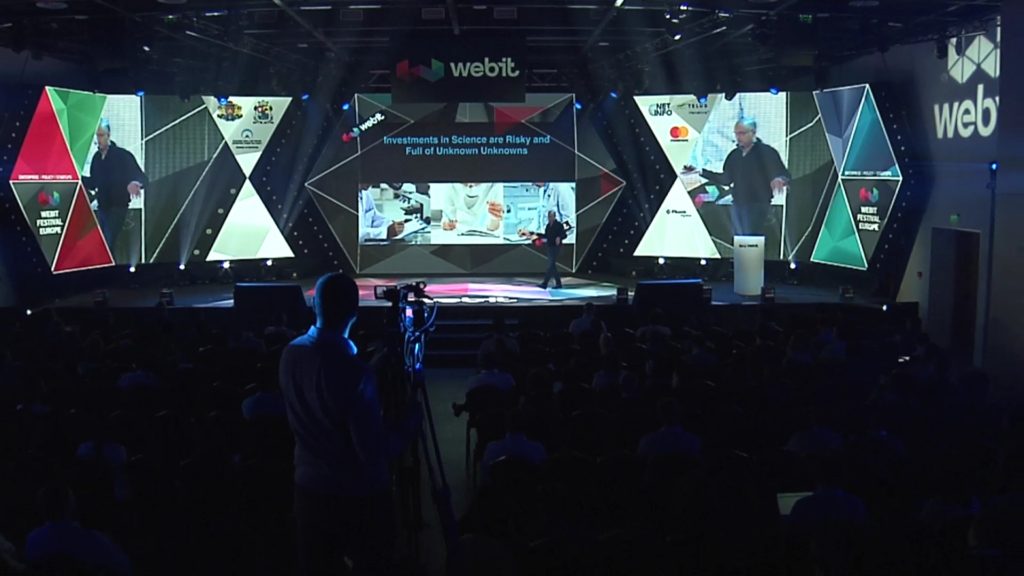 The Founder & CEO of Elemental Machines Sridhar Iyengar[/caption]
Right now pharmaceutical companies invest millions of dollars in research and development, but very little of this scientific world is actually connected to the Cloud. We already have smart homes and devices, and now is the time to develop smart laboratories and factories that are able to share their results and reap the power of cloud computing.
Maybe the best example of that is the San Francisco company Emerald Cloud Lab (ECL), which Iyengar described as “the Amazon for science”. It has developed a fully robotized laboratory. If you have a science experiment you just have to go to their website and code the process and machines will execute it.
The first cloud connected laboratory in the entire world gets the human error out of the equation and guarantees the same results in every execution of the process. In the long-term offering experimentation as service may revolutionize the science-based businesses by cutting their costs and removing the need to develop their own research in development facilities.
Another example of great innovation is the Bay Area company VIUM, which have a digital mouse lab and removes the actual mice from the drug test process. It collect terabytes of data on mice with dozens of sensors.
The Founder & CEO of Elemental Machines Sridhar Iyengar[/caption]
Right now pharmaceutical companies invest millions of dollars in research and development, but very little of this scientific world is actually connected to the Cloud. We already have smart homes and devices, and now is the time to develop smart laboratories and factories that are able to share their results and reap the power of cloud computing.
Maybe the best example of that is the San Francisco company Emerald Cloud Lab (ECL), which Iyengar described as “the Amazon for science”. It has developed a fully robotized laboratory. If you have a science experiment you just have to go to their website and code the process and machines will execute it.
The first cloud connected laboratory in the entire world gets the human error out of the equation and guarantees the same results in every execution of the process. In the long-term offering experimentation as service may revolutionize the science-based businesses by cutting their costs and removing the need to develop their own research in development facilities.
Another example of great innovation is the Bay Area company VIUM, which have a digital mouse lab and removes the actual mice from the drug test process. It collect terabytes of data on mice with dozens of sensors.
“I’m from Boston and biotech companies here raise $40 million as their first round of investment. And most companies don’t raise that much money through the entire process of their existence. Yet if you are going to develop a drug it is going to cost you tens, or even hundreds of millions of dollars”, the expert explained.People who work in technology fields understand Moore’s Law and the fact that the processing power of computers is growing exponentially. But what most of us don’t realize is that in biotech world it is quite the opposite. Eroom’s Law (Moore’s Law spelled backwards) says that as the years goes on the amount of money needed to produce new a single drug is growing. So for every $1 billion dollars that is invested into making a new drug, you get less and less ROI. One of the main obstacles before making science is the fact that every activity is done in the physical world. This creates hundreds of factors that influence and cause variations in the end result. According to Iyengar doing science is very similar to writing code. Working in a laboratory or a manufacturing facility requires following a procedure and a protocol. Code is nothing more than a set of procedures and steps that machine executes. When things co wrong in code, developers have tools, called debuggers. But in science there are no such tools and the debugging process is much harder.
“It is pretty much like baking a cake. You follow recipe, you bake it and supposedly you should get the cake out. If each of us took home the same recipe for chocolate cake and we came back tomorrow, we will probably have dozens of slightly different kinds of cakes, even that we followed the same procedure. In cooking it is okay, but when you are making a drug, it is no”, he said.In software our operating system may be iOS, Windows, Linux or else. But in science-based industry the operating system is the physical world. Because every time doing experiment, every time you test something on a mouse, every time you do a sequence of a genome, the physical world changes. And if you are trying to do the same things in two different days, you have to make sure that all the conditions are the same. This is the most important thing about science - that everything is based on physical properties. When something goes wrong with your final product there are millions things that could have caused why it could went wrong. And finding that is actually really hard and takes a lot of time and resources. [caption id="attachment_5044" align="aligncenter" width="640"]
 The Founder & CEO of Elemental Machines Sridhar Iyengar[/caption]
Right now pharmaceutical companies invest millions of dollars in research and development, but very little of this scientific world is actually connected to the Cloud. We already have smart homes and devices, and now is the time to develop smart laboratories and factories that are able to share their results and reap the power of cloud computing.
Maybe the best example of that is the San Francisco company Emerald Cloud Lab (ECL), which Iyengar described as “the Amazon for science”. It has developed a fully robotized laboratory. If you have a science experiment you just have to go to their website and code the process and machines will execute it.
The first cloud connected laboratory in the entire world gets the human error out of the equation and guarantees the same results in every execution of the process. In the long-term offering experimentation as service may revolutionize the science-based businesses by cutting their costs and removing the need to develop their own research in development facilities.
Another example of great innovation is the Bay Area company VIUM, which have a digital mouse lab and removes the actual mice from the drug test process. It collect terabytes of data on mice with dozens of sensors.
The Founder & CEO of Elemental Machines Sridhar Iyengar[/caption]
Right now pharmaceutical companies invest millions of dollars in research and development, but very little of this scientific world is actually connected to the Cloud. We already have smart homes and devices, and now is the time to develop smart laboratories and factories that are able to share their results and reap the power of cloud computing.
Maybe the best example of that is the San Francisco company Emerald Cloud Lab (ECL), which Iyengar described as “the Amazon for science”. It has developed a fully robotized laboratory. If you have a science experiment you just have to go to their website and code the process and machines will execute it.
The first cloud connected laboratory in the entire world gets the human error out of the equation and guarantees the same results in every execution of the process. In the long-term offering experimentation as service may revolutionize the science-based businesses by cutting their costs and removing the need to develop their own research in development facilities.
Another example of great innovation is the Bay Area company VIUM, which have a digital mouse lab and removes the actual mice from the drug test process. It collect terabytes of data on mice with dozens of sensors.
“They know how much they sleep, how much they walk around, which direction is their nose pointed, how often they feed. And every single thing is captured, so that when something goes wrong you have a huge database where you can go through and debug what may have happened”, Iyengar said.Тhese are two examples of how IoT, connected devices and cloud computing are being applied to drug discovery and science and research, but there are many more to come. You may watch Sridhar Iyengar’s full lecture here: If you want to keep up with the latest trend in the world of digital economy and technology, then Webit.Festival is the right place for you. Visit our website and book 2 of our Super Earlybird tickets for Webit.Festival Europe 2018 for just €100. Feel the Webit vibe with some of the best photos from this year’s event! [easingslider id="4954"]
The Millennials expect brands to know them not as a segment,...
Few years ago the Executive Chairman of Google Eric Schmidt predicted that soon it will be very hard for people to watch or consume something that is not in some sense been tailored especially for them. And as the Millennial generation becomes a bigger and bigger part of the consumer population marketers realize that this is quickly becoming reality.
The challenge before the marketing experts worldwide is to catch up with this giant trend and to find new ways to personalize their products and services and make them relevant for the Generation Y.
And during Webit.Festival Europe the Chief Marketing Officer of Selligent Nick Worth shared his vision about the evolution of his profession in the Digital age and the changing consumer behavior.
Nick joined the Selligent Executive Advisory Board in 2013, and became the company’s first CMO a year later. Selligent was recently recognized by Venture Beat as the world's fastest growing marketing automation company. Today, it offers the world’s first relationship marketing platform that can deliver on the promise of consumer-first marketing with contextually
The main hypothesis behind this success is that people live in moments, and the moment is the key to marketing, because that is when somebody has to make a big decision.
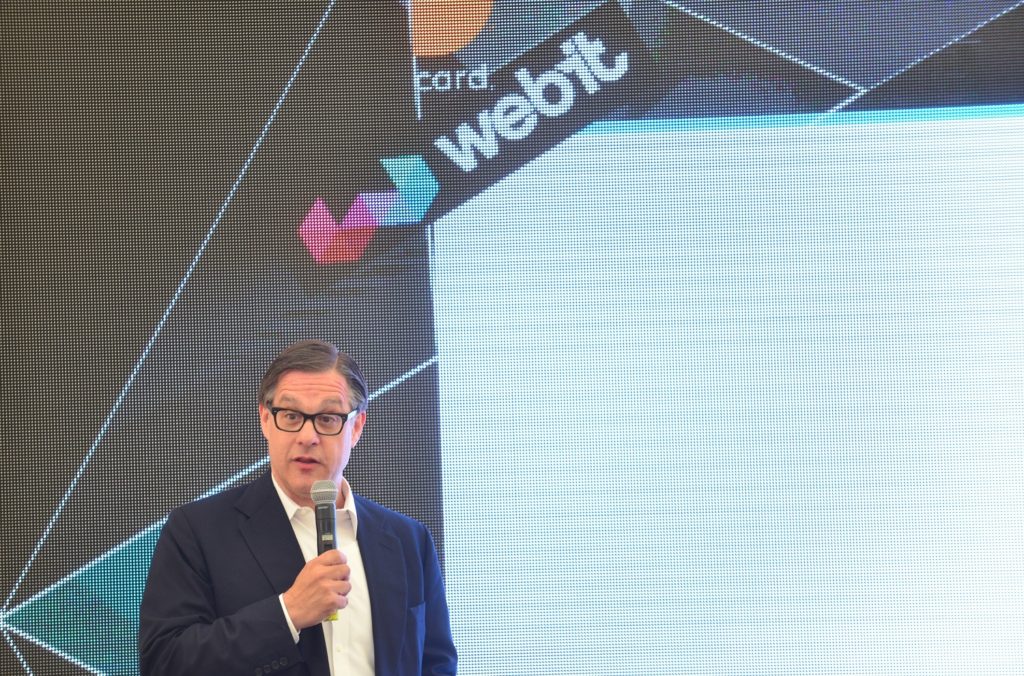 The Chief Marketing Officer of Selligent Nick Worth [/caption]
The person that thinks that cereal is inconvenient is called the entitled consumer. He believes that he is inherently deserving of privileges of special treatment. 90% of us expect real-time customer service. 78% expect automatic payments and checkouts. 79% expect same-day delivery. 53% expect retailers to learn their taste and make suggestions. 48% even expect that there will be a service that ships products before they order them. This is an actual thing that is called Anticipatory commerce.
All businesses today have to market in a world where people think that they are going to order products with their brains and the marketers will just know where to send them. And this is a tough world to live in.
The Chief Marketing Officer of Selligent Nick Worth [/caption]
The person that thinks that cereal is inconvenient is called the entitled consumer. He believes that he is inherently deserving of privileges of special treatment. 90% of us expect real-time customer service. 78% expect automatic payments and checkouts. 79% expect same-day delivery. 53% expect retailers to learn their taste and make suggestions. 48% even expect that there will be a service that ships products before they order them. This is an actual thing that is called Anticipatory commerce.
All businesses today have to market in a world where people think that they are going to order products with their brains and the marketers will just know where to send them. And this is a tough world to live in.
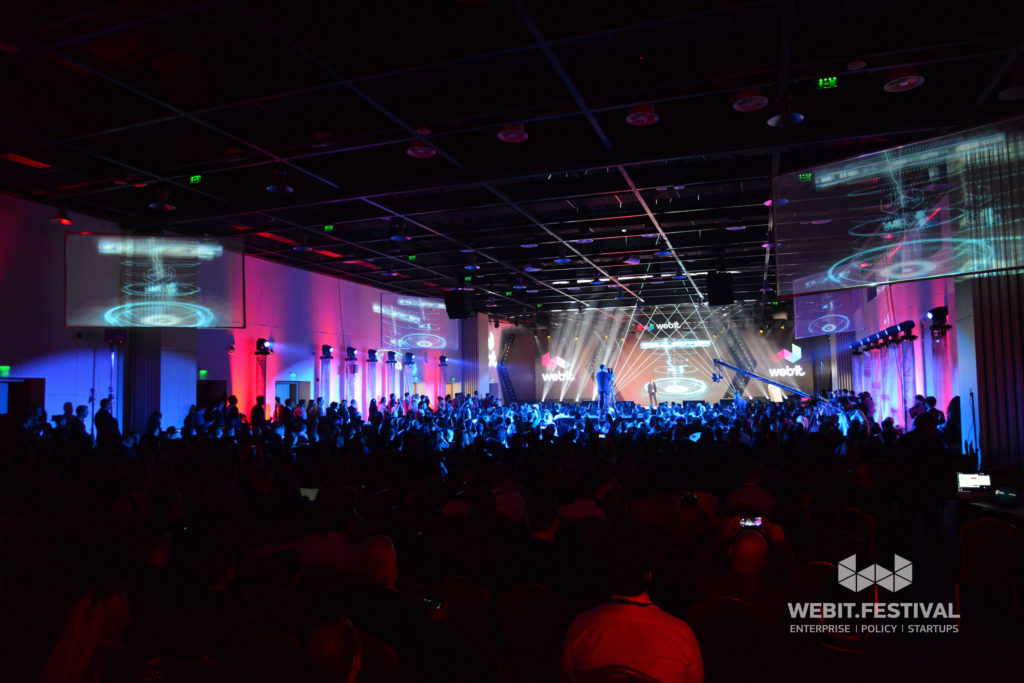 Another interesting example is ING. Like all retail banks their biggest challenge is getting new customers because new customers in banks are young people. You want to get them in university or first job and then build a relationship that will last for years.
Rather than reaching out to young people in Belgium on the basis of how great their banking services are, they try to think about what young people do in Europe during the summer. They go to music festivals, because they are fun. But music festivals have problems. There is no parking, there are no toilets, there is no place to charge your phone. If you are caring a lot of valuable stuff there is no place to put them. If you want to share your experience with your friends it is hard to do it because there is no signal.
So ING built its summer festival campaign using technology to provide young people with all these things. This gives ING the opportunity to gather a lot of information about these potential new customers. Meanwhile young people tell to themselves that there is a bank that understands what they want, even if it has nothing to do with banking.
You may watch Nick Worth’s full lecture here:
If you want to keep up with the latest trend in the world of digital economy and technology, then Webit.Festival is the right place for you. Visit our website and book 2 of our Super Earlybird tickets for Webit.Festival Europe 2018 for just €100.
Feel the Webit vibe with some of the best photos from this year’s event!
[easingslider id="4954"]
Another interesting example is ING. Like all retail banks their biggest challenge is getting new customers because new customers in banks are young people. You want to get them in university or first job and then build a relationship that will last for years.
Rather than reaching out to young people in Belgium on the basis of how great their banking services are, they try to think about what young people do in Europe during the summer. They go to music festivals, because they are fun. But music festivals have problems. There is no parking, there are no toilets, there is no place to charge your phone. If you are caring a lot of valuable stuff there is no place to put them. If you want to share your experience with your friends it is hard to do it because there is no signal.
So ING built its summer festival campaign using technology to provide young people with all these things. This gives ING the opportunity to gather a lot of information about these potential new customers. Meanwhile young people tell to themselves that there is a bank that understands what they want, even if it has nothing to do with banking.
You may watch Nick Worth’s full lecture here:
If you want to keep up with the latest trend in the world of digital economy and technology, then Webit.Festival is the right place for you. Visit our website and book 2 of our Super Earlybird tickets for Webit.Festival Europe 2018 for just €100.
Feel the Webit vibe with some of the best photos from this year’s event!
[easingslider id="4954"]
“We think about that in terms of something called consumer-first marketing. Traditionally marketers start with a program and channel. We think that you need to turn that upside down and start with the need of the person”, Worth explained.Consumer-first marketing inverts the traditional approach to marketing. It focuses on consumers to identify opportunities for filling the unmet need, entertaining or solving a pressing problem. It all starts with the need, treating it with integrity and listening to what consumers are telling about their requirements. As a marketer in the Digital age, you have to first be empathetic, and then deliver something that is relevant to the moment. As an example for the ever changing behavior of the consumer, Worth talked about the development of cereal breakfast market in the US during the last couple of decades. He remembered that when he was a kid his family always gathered in the morning to eat cereal as a time for bonding together. The reason the used this kind of food because it was convenient and fast to prepare. Later in college he ate cereal, not only for the convenience, but because of the low price. In the same time statistics show that cereal sales in the US are declining. The reason people don’t want to eat cereal any more is that it need a bowl and spoon that you have to clean. What happened is that this product went for being super popular because of its convenience to being unpopular for the exact opposite reason. What is taking off in the US is the sales of whole food bars. You just have to unwrap it and eat it. The point is that while the cereal stayed exactly the same during the years, the people have changed. And their expectations about what seems convenient changed too. [caption id="attachment_5037" align="aligncenter" width="640"]
 The Chief Marketing Officer of Selligent Nick Worth [/caption]
The person that thinks that cereal is inconvenient is called the entitled consumer. He believes that he is inherently deserving of privileges of special treatment. 90% of us expect real-time customer service. 78% expect automatic payments and checkouts. 79% expect same-day delivery. 53% expect retailers to learn their taste and make suggestions. 48% even expect that there will be a service that ships products before they order them. This is an actual thing that is called Anticipatory commerce.
All businesses today have to market in a world where people think that they are going to order products with their brains and the marketers will just know where to send them. And this is a tough world to live in.
The Chief Marketing Officer of Selligent Nick Worth [/caption]
The person that thinks that cereal is inconvenient is called the entitled consumer. He believes that he is inherently deserving of privileges of special treatment. 90% of us expect real-time customer service. 78% expect automatic payments and checkouts. 79% expect same-day delivery. 53% expect retailers to learn their taste and make suggestions. 48% even expect that there will be a service that ships products before they order them. This is an actual thing that is called Anticipatory commerce.
All businesses today have to market in a world where people think that they are going to order products with their brains and the marketers will just know where to send them. And this is a tough world to live in.
“The Millennials expect brands to know them not as a segment but as an specific individuals. Their grandparents are worried about privacy online. What they worry about is relevance. They expect brands to give them individual experience. This is the first generation that don’t want to be thought about as a generation, but as individuals”, Worth said.An obvious example for this is the ever growing $200 billion fast food market in the US. Statistics show that Chipotle is taking over the McDonald’s because of the personalized products they offer. Their clients can pick every ingredient in the Mexican food they order. The entitled consumers want convenience, value and relevance. The average number of daily marketing messages per consumer have gone from 500 in 1920 to over 10 000 in 2016. We have become a world where people are giving brands about 8 seconds of attention, while the average level of attention span of a goldfish is around 9-10 seconds. One of the main problems is that Millennials are not multitasking. Instead, they are selectively paying attention to one thing tuning out others and then switching. That means that if you want to send a teenager a message you have got to tune out other things.
 Another interesting example is ING. Like all retail banks their biggest challenge is getting new customers because new customers in banks are young people. You want to get them in university or first job and then build a relationship that will last for years.
Rather than reaching out to young people in Belgium on the basis of how great their banking services are, they try to think about what young people do in Europe during the summer. They go to music festivals, because they are fun. But music festivals have problems. There is no parking, there are no toilets, there is no place to charge your phone. If you are caring a lot of valuable stuff there is no place to put them. If you want to share your experience with your friends it is hard to do it because there is no signal.
So ING built its summer festival campaign using technology to provide young people with all these things. This gives ING the opportunity to gather a lot of information about these potential new customers. Meanwhile young people tell to themselves that there is a bank that understands what they want, even if it has nothing to do with banking.
You may watch Nick Worth’s full lecture here:
If you want to keep up with the latest trend in the world of digital economy and technology, then Webit.Festival is the right place for you. Visit our website and book 2 of our Super Earlybird tickets for Webit.Festival Europe 2018 for just €100.
Feel the Webit vibe with some of the best photos from this year’s event!
[easingslider id="4954"]
Another interesting example is ING. Like all retail banks their biggest challenge is getting new customers because new customers in banks are young people. You want to get them in university or first job and then build a relationship that will last for years.
Rather than reaching out to young people in Belgium on the basis of how great their banking services are, they try to think about what young people do in Europe during the summer. They go to music festivals, because they are fun. But music festivals have problems. There is no parking, there are no toilets, there is no place to charge your phone. If you are caring a lot of valuable stuff there is no place to put them. If you want to share your experience with your friends it is hard to do it because there is no signal.
So ING built its summer festival campaign using technology to provide young people with all these things. This gives ING the opportunity to gather a lot of information about these potential new customers. Meanwhile young people tell to themselves that there is a bank that understands what they want, even if it has nothing to do with banking.
You may watch Nick Worth’s full lecture here:
If you want to keep up with the latest trend in the world of digital economy and technology, then Webit.Festival is the right place for you. Visit our website and book 2 of our Super Earlybird tickets for Webit.Festival Europe 2018 for just €100.
Feel the Webit vibe with some of the best photos from this year’s event!
[easingslider id="4954"]
Exclusive content is what drives the audience in the Digital age
In the digital world we live in we get information about what is happening around the globe literally on every second. In an information environment like that the task of running a newspaper may seem almost impossible, especially if you want to reach the young audiences and Мillennials in general.
But there are more than several examples around the world of successful symbiosis between the old school analytical journalism and the fast lane news reporting using the tools that digital technology gives us.
During this year’s Webit.Festival Europe our guest had the chance to listen to the Global Entertainment Director of Telegraph Media Group talking about the customer journey through creative content and the right balance between engagement and scale in the media industry nowadays.
Parkinson has over 20 years experience in all aspects of Marketing and Distribution in the UK and International film distribution industry. Starting her career in the marketing department of the legendary Palace Pictures and then going on to roles as Promotions Manager at United International Pictures followed by 11 years as Head of Film across the Emap portfolio. Denise's most recent roles have included Director of International Marketing for Europe, Middle East and Africa for Disney, ABC and ESPN Television and Global Entertainment Director for Yahoo!
Recently she was asked by The Telegraph to develop the film category of their news. Now she works closer with the movie studios, while her work is increasing the revenue and contend on all communication channels of the 200-years old newspaper.
Expanding a media institution like The Telegraph to reach the digital audience is definitely not an easy task. The newspaper is a classic broadsheet with conservative analysis and old school media approach. But now its movie section is reaching the mass public, making the studios happy and getting a big part of their revenue through promotion campaigns.
That level of success required a complete reform in the way the media is producing content that work seamlessly with its digital and print products. And while the newspaper may look like a conservative broadsheet, the app is bright,visual and simple to use and give us the option to choose only the content we want to see and get notifications about the breaking news in the respective categories.
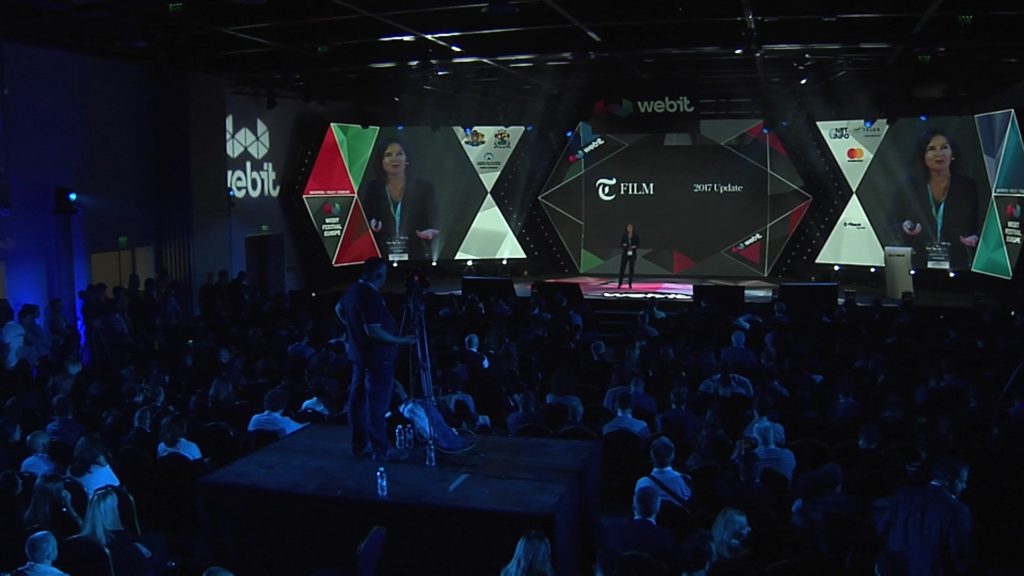 The Global Entertainment Director at Telegraph Media Group Denise Parkinson[/caption]
For the last several years The Telegraph established itself as the go to media when searching information about upcoming movies with its exclusive content and innovative Omni-channel approach.
The Global Entertainment Director at Telegraph Media Group Denise Parkinson[/caption]
For the last several years The Telegraph established itself as the go to media when searching information about upcoming movies with its exclusive content and innovative Omni-channel approach.
“This segment is about the consumer journey. It’s so hard to get cut through now and get stand through. It’s so hard to get people to go to the movie, when there is Netflix and Amazon and so many enticements to just stay at home and watch on your tablet”, Parkinson said.Today, The Telegraph is not just a quality newspaper for the British public, but a 360 degrees publisher with global reach through online website, mobile app and print edition. It has 22.5 monthly users. 6.7 million of them are reading news on a desktop computer, 4.4 million in print and 16.6 on various devices, so the mobile is really the growth area for the future. And while the media is publishing some premium content as part of its monetization strategy, 80% of the content is free and easy to access for the user. If you want in-depth analysis from any of The Telegraph’s columnists on sport, politics, entertainment, lifestyle etc., you need to pay a small monthly fee to access the premium sections of the newspaper online editions. With that, you also get subscribers benefits and unique opportunities, including even red carpet experiences. [caption id="attachment_5028" align="aligncenter" width="640"]
 The Global Entertainment Director at Telegraph Media Group Denise Parkinson[/caption]
For the last several years The Telegraph established itself as the go to media when searching information about upcoming movies with its exclusive content and innovative Omni-channel approach.
The Global Entertainment Director at Telegraph Media Group Denise Parkinson[/caption]
For the last several years The Telegraph established itself as the go to media when searching information about upcoming movies with its exclusive content and innovative Omni-channel approach.
“We are number 1 for cinema goers. That means that we have more cinema goers engaging with our brands than our competition. This is really important message to send to the film studios and to work with them on their promotions. We have a young audience. So for an old newspaper that has got a conservative tone and voice it’s really fantastic to know that we index much higher with youth audience more than you would expect. We actually have more users than Buzzfeed”, Parkinson said.As an example of the 360 degrees approach of the media she pointed out the exclusive interview with the Hollywood star Adam Driver. The Telegraph ran an online competition and gave its audience a chance to come to the interview, watch the film “Paterson” before its official premiere and meet the actor in person. Right now Adam Driver is really huge star because of his role as Kylo Ren in the reboot of the Star Wars saga and this kind of award is very interesting for the readers. The interview was streamed live for the people, who couldn’t win the tickets. According to Parkinson this is a complete integrated promotion that fits the distributor’s every need. Because they get a lot of pre-promotion, when the media was promoting the competition, that happened about 2 weeks before the film was released. And just a few days before the premiere the live interview happened. That interview was then edited and uploaded on the site to sustain the interest couple of weeks after the movie was released.
“It’s a win win and we get exclusive content which means if you are Adam Driver fan we are the only place that you can come to. So the most important thing is getting exclusives, because exclusives are what drives audience”, she explained.Going back to the old school approach, the newspaper was able to integrate the legacy of the brand and produce some engaging advertorials, because in the media business everything is about the engagement and keeping the audience on the page as long as possible. You may watch the full lecture of Denise Parkinson here: If you want to keep up with the latest trend in the world of digital economy and technology, then Webit.Festival is the right place for you. Visit our website and book 2 of our Super Earlybird tickets for Webit.Festival Europe 2018 for just €100. Feel the Webit vibe with some of the best photos from this year’s event! [easingslider id="4954"]
Esports and Gaming are defining entertainment for millennials
We all know at least one nerdy guy, who never leaves his parents place and is always playing video games with his friends online. Well guess what? He now has the chance to build his own Cinderella story and become a real rockstar without the need to give up on his hobby. In fact, he can even make a professional career out of it and compete for millions dollar prize at tournaments all over the world.
This is not a story taken from a Hollywood movie that is trying to make the nerds worldwide feel better about themselves. It is the reality of Esports - a trend that is driving the entertainment trends for hundreds of millions millennials around the globe.
At this year’s Webit.Festival Europe our guests had the chance to hear the CEO of MTGx Digital Ventures Arnd Benninghoff explaining the world of competitive Gaming and the amazing opportunities it creates for the entertainment market.
During his presentation he shared his views about the future of this new industry and compared it to the performance of other traditional sports during the last several years.
As an example of the impact of Esports today he showed the audience a YouTube video of the gamer “jackspeticeye” playing Rocketball - a game that is soon going to become a part of the official tournaments. He is playing games, commenting on this and gathering millions of views. The player now has over 15 million subscribers, while the video itself is viewed more than 4.2 million times.
And this is not at all a single case. In fact digital influencers all around the world gather millions of followers with new video format. Now they don’t need production companies, because they are able to produce videos from their living rooms.
Recent polls show that millennial stars come from the digital universe. In fact if you look at the top 10 influencers for the Generation Y you will find only two people from showbusiness. All the others are online stars, like the biggest youtuber PewDiePie, who now has over 55 million subscribers.
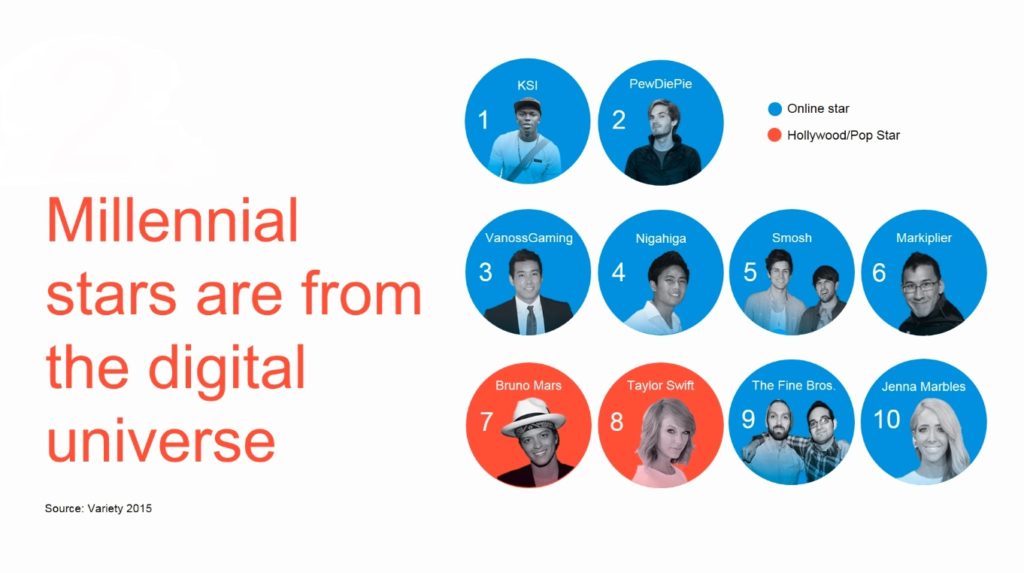
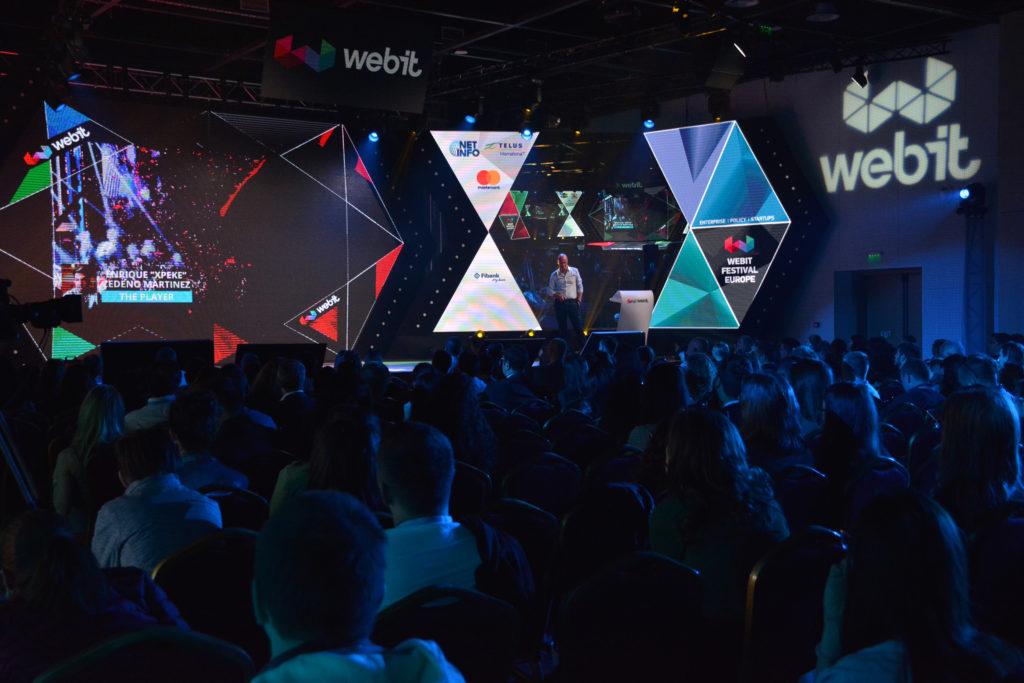 The CEO of MTGx Digital Ventures Arnd Benninghoff.[/caption]
There are now more than 2.2 billion gamers, while if you look at traditional sport there are about 2 billion sport fans. We have more than 20 relevant Esports games and over 200 professional Esports teams. These players do nothing but playing games. They live with their teammates in gaming houses, travel the world and competing for millions of prize money. And there are more than 324 million fans watching them on online platforms and already on TV.
Esports opens doors to millennials that are usually hard to reach via traditional media. They have credit cards next to them and you can easily convert them into buyers. That is the reason why the big brands now enter Esports. Corporations like Coca-Cola, Red Bull, Intel, Mastercard and Geico are investing in their own teams. Even traditional football clubs like Wolfsburg, PSG and Schalke 04 are planning Esports teams.
The CEO of MTGx Digital Ventures Arnd Benninghoff.[/caption]
There are now more than 2.2 billion gamers, while if you look at traditional sport there are about 2 billion sport fans. We have more than 20 relevant Esports games and over 200 professional Esports teams. These players do nothing but playing games. They live with their teammates in gaming houses, travel the world and competing for millions of prize money. And there are more than 324 million fans watching them on online platforms and already on TV.
Esports opens doors to millennials that are usually hard to reach via traditional media. They have credit cards next to them and you can easily convert them into buyers. That is the reason why the big brands now enter Esports. Corporations like Coca-Cola, Red Bull, Intel, Mastercard and Geico are investing in their own teams. Even traditional football clubs like Wolfsburg, PSG and Schalke 04 are planning Esports teams.

“More than 40% of the millennials in the US between 18 and 24 years of age are leaving the traditional TV and they are not coming back. What defines their life and their pop culture is games. Games are relevant storytelling. They spend an average of 107 minutes per day playing video games compared to 139 minutes watching live TV”, Benninghoff said.The new sport for this generation is called Esports. This is competitive Gaming that is able to fill big stadiums and now gives gamers the opportunity to play for millions prize money. The statistics of the streaming platforms can easily show us that it is getting even bigger than the traditional sports. Online Gaming means that you start your journey by downloading a game. You start playing the game, then you become a hero and spend hours playing the game. And guess what you do? You want to share your videos on Twitch. You are going to broadcast yourself. Then if you are really good, you will start playing in a team and become a pro gamer, which will be a new career for millions of youngsters. For the broadcasters Gaming is so interesting because it is often free to play. This means that you can just download the game you like and begin a story that can took hundreds of hours of playing time to complete. And now more than 30% of the daily mobile usage is Gaming. The average millennial is spending at least 1 hour per day into this. Benninghoff predicted that soon Esports are going to be added in the Olympic sports calendar. It only depends on the age of the International Olympic Committee members and when will they accept that this is already bigger than most of the other sports. According to ESPN analysts for the first time in generations we are witnessing the birth of a new sport. Gaming is what every traditional sports league is desperate to become - young, global, digital and increasingly diverse. [caption id="attachment_5014" align="aligncenter" width="640"]
 The CEO of MTGx Digital Ventures Arnd Benninghoff.[/caption]
There are now more than 2.2 billion gamers, while if you look at traditional sport there are about 2 billion sport fans. We have more than 20 relevant Esports games and over 200 professional Esports teams. These players do nothing but playing games. They live with their teammates in gaming houses, travel the world and competing for millions of prize money. And there are more than 324 million fans watching them on online platforms and already on TV.
Esports opens doors to millennials that are usually hard to reach via traditional media. They have credit cards next to them and you can easily convert them into buyers. That is the reason why the big brands now enter Esports. Corporations like Coca-Cola, Red Bull, Intel, Mastercard and Geico are investing in their own teams. Even traditional football clubs like Wolfsburg, PSG and Schalke 04 are planning Esports teams.
The CEO of MTGx Digital Ventures Arnd Benninghoff.[/caption]
There are now more than 2.2 billion gamers, while if you look at traditional sport there are about 2 billion sport fans. We have more than 20 relevant Esports games and over 200 professional Esports teams. These players do nothing but playing games. They live with their teammates in gaming houses, travel the world and competing for millions of prize money. And there are more than 324 million fans watching them on online platforms and already on TV.
Esports opens doors to millennials that are usually hard to reach via traditional media. They have credit cards next to them and you can easily convert them into buyers. That is the reason why the big brands now enter Esports. Corporations like Coca-Cola, Red Bull, Intel, Mastercard and Geico are investing in their own teams. Even traditional football clubs like Wolfsburg, PSG and Schalke 04 are planning Esports teams.
“Over the last few years the distribution platforms are driving the growth and even Facebook is entering live streaming for Esports. The TV stations are also experimenting with Esports content to bring back the millennials. And the next level will be VR where you can join the game, stand in the middle of the things happening and follow the action”, the expert said.Compared to the $100 billion games market Esports is still a niche market. But by 2020 it is expected to grow by 40% compared to the data for 2015. Asia is now waking up and China is going to be one of the biggest markets over the next year. This year the biggest Esports event happened in the Polish city Katowice and gathered more than 160 000 attendees and over 50 million viewers online. And if you still are not a believer of the Esports Cinderella story, just watch the trailer of the tournament and feel its atmosphere. You may watch Arnd Benninghoff’s full lecture here: If you want to keep up with the latest trend in the world of digital economy and technology, then Webit.Festival is the right place for you. Visit our website and book 2 of our Super Earlybird tickets for Webit.Festival Europe 2018 for just €100. Feel the Webit vibe with some of the best photos from this year’s event! [easingslider id="4954"]
How the Internet took away our ability to understand the world...
Over the past few decades the art of marketing has developed in an increasingly globalized world - a trend, that was only accelerated by the emergence of internet and digital technology. During that period of time we had almost a global liberal consensus, both politically and socially, about the path our world must take. But right now it looks like this world order is on its way to an inevitable collapse and this is something that leads to a massive change the way the companies are approaching consumers.
A lot of the brands that we know today took over in the last 25 years and were built on the basis of a global and unified world. In the reality now this is no longer true, because we realized that this concept can’t hold. There are people and constituencies around the world who had been left behind by globalization, who haven’t received benefits as much as other groups. And as a result of that we have the rise of populism. It has given us Trump in the USA, it has given us Brexit in the UK and perhaps even more horribly the phenomenon of grabbing power in Turkey.
During the recent Webit.Festival Europe we had the chance to hear these trends explained by the Chief Creative Officer of DigitasLBi Chris Clarke. During his presentation he talked about the death of empathy in the information age and shared his vision on the changes that needs to be made in order to protect our society from the dark and unintended consequences of the idea of free information.
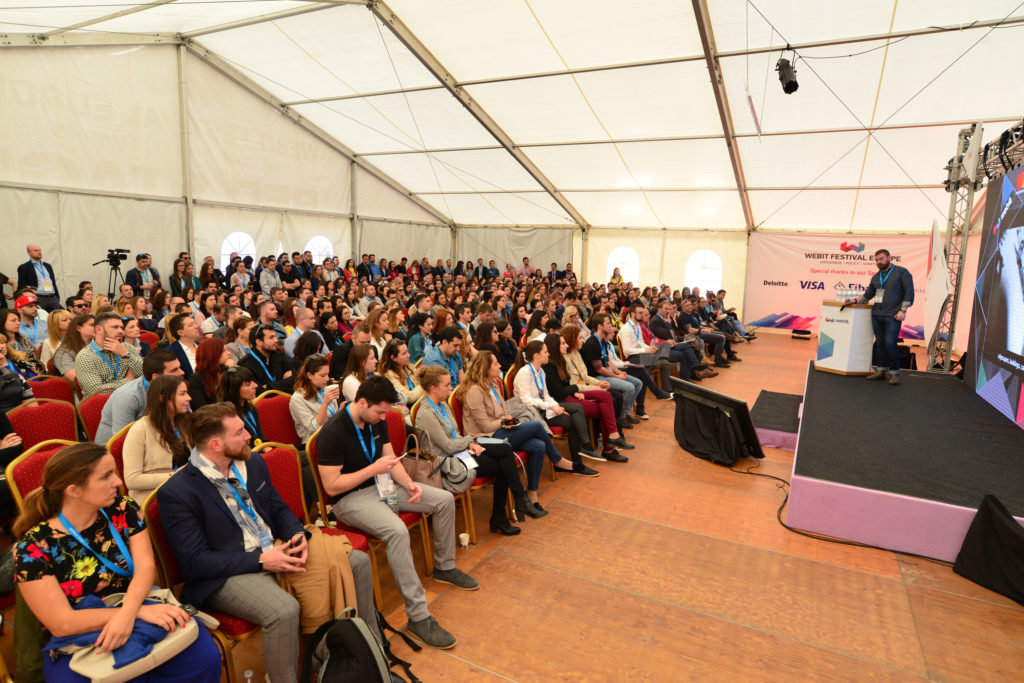 The Chief Creative Officer of DigitasLBi Chris Clarke[/caption]
Back in 2012 when Instagram was bought by Facebook for a $1 billion was the year when Kodak went bust. In its peak Kodak employed 300 000 people around the world and it made revenues of $3-4 billion a year. When Instagram was bought for a billion Instagram had 30 employees and made revenues of $0. So there are some major challenges in terms of value destruction, as well as value creation when it comes to digital disruption.
As someone who describes himself as a cheerful dystopian, he warned that marketers must think about the impact of their works when advising brands about the brightest ways to operate in this space. Because the development of internet did not give control to the consumers - it took it away from them.
Today we are checking our phones regularly even when we should be playing with our children. The reason for this is the addiction we develop, because of the dopamine reward that the usage of different platforms is giving us.Clarke describes the social media and global businesses like Google and Facebook as the best system of population control ever invented.
The Chief Creative Officer of DigitasLBi Chris Clarke[/caption]
Back in 2012 when Instagram was bought by Facebook for a $1 billion was the year when Kodak went bust. In its peak Kodak employed 300 000 people around the world and it made revenues of $3-4 billion a year. When Instagram was bought for a billion Instagram had 30 employees and made revenues of $0. So there are some major challenges in terms of value destruction, as well as value creation when it comes to digital disruption.
As someone who describes himself as a cheerful dystopian, he warned that marketers must think about the impact of their works when advising brands about the brightest ways to operate in this space. Because the development of internet did not give control to the consumers - it took it away from them.
Today we are checking our phones regularly even when we should be playing with our children. The reason for this is the addiction we develop, because of the dopamine reward that the usage of different platforms is giving us.Clarke describes the social media and global businesses like Google and Facebook as the best system of population control ever invented.
“We are experiencing great social changes and they are completely changing the way brands need to communicate. Only 17 years ago the most powerful computer in the world was called the Big Red and was about the size of a room. Six years later the same processing power was available in the Sony PlayStation 3 and now it is available in the smartphones in our pockets”, he said.According to Clarke now it is almost impossible for any person or organization to really know what is happening in the world. The pace of change is very fast that it is almost impossible for governments and legislation to keep up. We have a growth of massive digital businesses that have disrupted whole industries and this comes with a big prize that someone has to pay. When The Cluetrain Manifesto, often regarded as the Bible for digital disruption, was released in 2009 we all took for granted the notion that information wants to be free and the idea of free content online. Now we can see that while the industrial disruption can create great opportunities, the problem is that the disrupted industries have not really been replaced in terms of jobs. We have the challenge that economists describe as “premature deindustrialization”. A developing country, like India for example, is trying hard to get the people out of the fields and put them into factories. But now the factories are operated by machines and apps, so they have to get people out of the fields and put them into educational institutions to teach them about software development, which is much bigger leap. That caused huge challenges and countries are struggling to keep up. [caption id="attachment_5006" align="aligncenter" width="640"]
 The Chief Creative Officer of DigitasLBi Chris Clarke[/caption]
Back in 2012 when Instagram was bought by Facebook for a $1 billion was the year when Kodak went bust. In its peak Kodak employed 300 000 people around the world and it made revenues of $3-4 billion a year. When Instagram was bought for a billion Instagram had 30 employees and made revenues of $0. So there are some major challenges in terms of value destruction, as well as value creation when it comes to digital disruption.
As someone who describes himself as a cheerful dystopian, he warned that marketers must think about the impact of their works when advising brands about the brightest ways to operate in this space. Because the development of internet did not give control to the consumers - it took it away from them.
Today we are checking our phones regularly even when we should be playing with our children. The reason for this is the addiction we develop, because of the dopamine reward that the usage of different platforms is giving us.Clarke describes the social media and global businesses like Google and Facebook as the best system of population control ever invented.
The Chief Creative Officer of DigitasLBi Chris Clarke[/caption]
Back in 2012 when Instagram was bought by Facebook for a $1 billion was the year when Kodak went bust. In its peak Kodak employed 300 000 people around the world and it made revenues of $3-4 billion a year. When Instagram was bought for a billion Instagram had 30 employees and made revenues of $0. So there are some major challenges in terms of value destruction, as well as value creation when it comes to digital disruption.
As someone who describes himself as a cheerful dystopian, he warned that marketers must think about the impact of their works when advising brands about the brightest ways to operate in this space. Because the development of internet did not give control to the consumers - it took it away from them.
Today we are checking our phones regularly even when we should be playing with our children. The reason for this is the addiction we develop, because of the dopamine reward that the usage of different platforms is giving us.Clarke describes the social media and global businesses like Google and Facebook as the best system of population control ever invented.
“People like to talk about the Arab spring as being a wonderful moment of social media giving start to great rebellion. But it didn’t exactly end up well, did it? Because even as Facebook is quite good for helping us organize ourselves, it’s pretty rubbish when we have to come up with alternative to a theocratic state, like Iran for example. People there are not thinking deeply about their issues, they are liking, passing on information, getting that quick dopamine reward and then moving on”, he said.The fact that most of the platforms we consume information from are tailored for us creates filter bubbles that took away from us the idea of what people, who are not like us, are reading or experiencing. This is why for many people it was surprise that Brexit and Trump happened - because these major world shaking events are forming inside someone else’s bubble. It is therefore impossible for a brand to address everybody with one campaign idea globally. Because each filter bubble is unique. Couple of years ago Google’s Executive Chairman Eric Schmidt predicted that it will be very hard for people to watch or consume something that is not in some sense been tailored for them. But despite this negative trends, Clarke is sure that the massive polarization of audiences gives the big brands a chance to stand up and be the driver behind the positive change in the world. The reason is that it is really difficult to mean something to anybody when you are occupying the middle space that is now disappearing. Right after Donald Trump introduced his Muslim ban in the USA, many brands stood up against this, risking to alienate part of their audiences and saying that money are less important than values. This is something that we did not often see in the past and can be an opportunity to have a real impact in the society.
“I genuinely think that there is a fantastic opportunity if we think in the right way of how the internet is configured, if we question it, if we don’t just pretend that the customer is in control, if we don’t just pretend it is all about democracy and laugh. If we recognize some of the darker sides of what we are building we can change it and make it better. And I think that brands have a fantastic role to play in that”, Chris Clarke said.You may watch his full lecture here: If you want to keep up with the latest trend in the world of digital economy and technology, then Webit.Festival is the right place for you. Visit our website and book 2 of our Super Earlybird tickets for Webit.Festival Europe 2018 for just €100. Feel the Webit vibe with some of the best photos from this year’s event! [easingslider id="4954"]
Innovation happens at the speed of trust, not technology
When we talk about digital transformation we often think about the tech giants like Google, Facebook and Amazon, which are spreading their online services to billions of people around the world. And while they may be the driver behind this huge process that is changing our daily lives, but the world economy is still hugely dependent on the results of the real world - the one that produces the goods and raw materials that we all need.
During this year’s Webit.Festival Europe the Partner for Europe and Innovation at VCI Roby Stancel spoke about the digital transformation processes in the primary sector, agriculture and mining industries.
Mr. Stancel brings two decades of uniquely broad experience in innovation, and helped create hundreds of products, services, strategies, roadmaps and cultural transformations for clients such as Apple, BMW, Nestle, P&G, or Siemens.
He manages the strategy for the world’s largest technology innovation consortium in mining with 150 partner companies. He created technology roadmaps for mining houses totaling a market cap of $300 bn.
The expert told Webit’s guests that one of the main rules during the development of the so called “design thinking” in Stanford 20 years ago was specifically looking at extreme users and customers because the difference between them and the average consumers is the best inspiration for innovation. That is the reason he tries to look at the digital transformation in the rest of the world, outside of the developed European and North American countries.
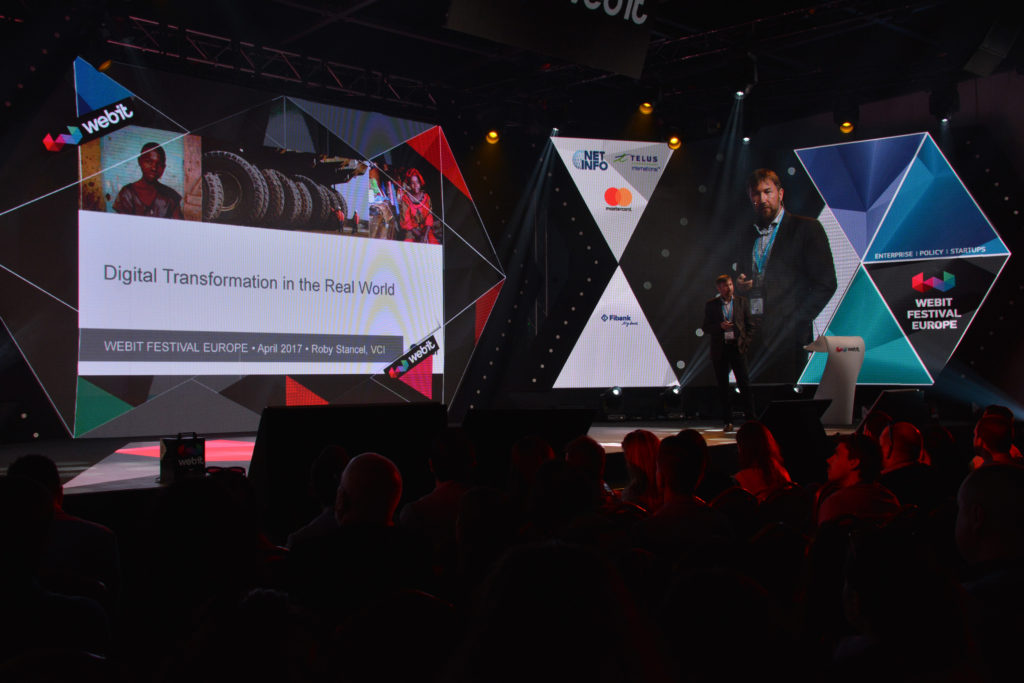 The Partner for Europe and Innovation at VCI Roby Stancel.[/caption]
Digitalization will revolutionize many real world industries so it won’t put them out of place. The automotive industry will still build cool cars and people will still want to drive their own vehicles because it means that they have freedom of movement.
But for example many big companies like VW are focusing on different aspects that can give them an added value. The German concern recently announced that it wants to be the best at weather forecasting. That means that every windshield wiper sensor and every traction control sensor in VW cars will tell the company exactly how the weather is in every place on the Earth. So the revolution in these German cars will be the ability to react to rapidly changing weather conditions.
The agriculture industry is also going through this. With a flying drone with infrared camera you can tell where there is enough water on the field and where there is not enough. And so therefore you can irrigate very focused and save a lot of resources. You can have for example the spray of chemicals can be greatly reduced because of this. You can also use weeding robots with optical recognition. They see the plants that we want and the weeds and pulls them up.
The Partner for Europe and Innovation at VCI Roby Stancel.[/caption]
Digitalization will revolutionize many real world industries so it won’t put them out of place. The automotive industry will still build cool cars and people will still want to drive their own vehicles because it means that they have freedom of movement.
But for example many big companies like VW are focusing on different aspects that can give them an added value. The German concern recently announced that it wants to be the best at weather forecasting. That means that every windshield wiper sensor and every traction control sensor in VW cars will tell the company exactly how the weather is in every place on the Earth. So the revolution in these German cars will be the ability to react to rapidly changing weather conditions.
The agriculture industry is also going through this. With a flying drone with infrared camera you can tell where there is enough water on the field and where there is not enough. And so therefore you can irrigate very focused and save a lot of resources. You can have for example the spray of chemicals can be greatly reduced because of this. You can also use weeding robots with optical recognition. They see the plants that we want and the weeds and pulls them up.
“But if I talk about the real world, let’s be clear about one thing. Software doesn’t do the work, real things and real people do. So unless your software is somehow connected to the real world you might have a very difficult time to convince people to do something about it”, he said.According to him, even if a company is number one in its industry, it can’t keep being successful only by advertising without creating real value because digitalization is going to wipe out many service industries in the next several years. He thinks that the current tech giant Facebook will disappear if it don’t manage to buy all the companies like WhatsApp that could be dangerous to them, because everyone hates Facebook. The users hate it because they have to view the world not through their eyes, but through a camera lens, helping them to post cool pictures in their feeds. The readers hate it because they sit on their desks and watch how everybody else is having a great time, which of course is an illusion. Companies hate it because they have to be there, so emotionally Facebook owns the world, but it is very loaded with negative value. And it is probably going to be replaced by a new company that offers similar reach but a better experience. Stancel is sure that the trust problems that many of the services we use today have will ultimately lead to their extinction.
“This is a main point. Innovation happens at the speed of trust, not at the speed of technology. You can dream up the most amazing things if you are able to put together all technology that we have today, but people will need to trust it”, the expert explained.As an example he pointed out the coming of the email - an event that was supposed to create the paperless office. But in the first years after its adoption, the emails led to an explosion in the amounts of paper used in offices around the world. Only now, a generation later, we actually have paperless offices, as the digital natives come into the workforce. So it is about the trust that people put into something, not in the technology. Another similar case is Tesla’s autopilot - a service that many people do not consider safe enough. According to Stancel the autonomous driving technology was available in the beginning of the century but just now the automakers think it is appropriate to start rolling it out into the mass production vehicles, because the society may be ready for that kind of change. [caption id="attachment_5000" align="aligncenter" width="640"]
 The Partner for Europe and Innovation at VCI Roby Stancel.[/caption]
Digitalization will revolutionize many real world industries so it won’t put them out of place. The automotive industry will still build cool cars and people will still want to drive their own vehicles because it means that they have freedom of movement.
But for example many big companies like VW are focusing on different aspects that can give them an added value. The German concern recently announced that it wants to be the best at weather forecasting. That means that every windshield wiper sensor and every traction control sensor in VW cars will tell the company exactly how the weather is in every place on the Earth. So the revolution in these German cars will be the ability to react to rapidly changing weather conditions.
The agriculture industry is also going through this. With a flying drone with infrared camera you can tell where there is enough water on the field and where there is not enough. And so therefore you can irrigate very focused and save a lot of resources. You can have for example the spray of chemicals can be greatly reduced because of this. You can also use weeding robots with optical recognition. They see the plants that we want and the weeds and pulls them up.
The Partner for Europe and Innovation at VCI Roby Stancel.[/caption]
Digitalization will revolutionize many real world industries so it won’t put them out of place. The automotive industry will still build cool cars and people will still want to drive their own vehicles because it means that they have freedom of movement.
But for example many big companies like VW are focusing on different aspects that can give them an added value. The German concern recently announced that it wants to be the best at weather forecasting. That means that every windshield wiper sensor and every traction control sensor in VW cars will tell the company exactly how the weather is in every place on the Earth. So the revolution in these German cars will be the ability to react to rapidly changing weather conditions.
The agriculture industry is also going through this. With a flying drone with infrared camera you can tell where there is enough water on the field and where there is not enough. And so therefore you can irrigate very focused and save a lot of resources. You can have for example the spray of chemicals can be greatly reduced because of this. You can also use weeding robots with optical recognition. They see the plants that we want and the weeds and pulls them up.
“As a matter of fact you can have infrared lasers that kills bugs and imagine if you could replace chemicals and GMO crops with digital technology. And it is happening so I’m with fingers crossed”, he said.You may watch his full lecture here: If you want to keep up with the latest trend in the world of digital economy and technology, then Webit.Festival is the right place for you. Visit our website and book 2 of our Super Earlybird tickets for Webit.Festival Europe 2018 for just €100. Feel the Webit vibe with some of the best photos from this year’s event! [easingslider id="4954"]
